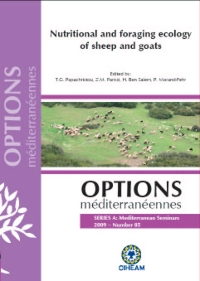| Article précédent | p. 279-283 | Article suivant |
Phytogenic additives to decrease in vitro ruminal methanogenesis
Six plants (Carduus pycnocephalus, Populus tremula, Prunus avium, Quercus robur, Rheum nobile and Salix caprea) were tested to determine their effects as feed additives to decrease ruminal methanogenesis in vitro. The plants had been selected in a previous screening assay in which a collection of 450 plant species had been tested. Sheep fed alfalfa hay were used as donors for rumen fluid. Batch cultures were performed in 120 ml serum bottles, using 10 ml strained rumen, 40 ml medium, 500 mg DM substrate (50% alfalfa hay, 40% grass hay and 10% barley) and 50 mg DM freeze-dried ground plant additive. After 24 h of incubation, gas production, methane and volatile fatty acids (VFA) production, propionate to acetate ratio, in vitro DM digestibility, pH and fermentation efficiency were measured. All the plants tested reduced methane production (P < 0.001) in relation to the control (no plant added). P. avium and Q. robur caused a decrease in propionate production and in propionate to acetate ratio (P < 0.001), whereas S. caprea reduced propionate production (P < 0.001). Gas production, pH and fermentation efficiency were not affected by any of the plants (P > 0.05). Among them, R. nobile was particularly promising since it showed the greatest and most consistent effect on methane production (-16% in relation to the control, P < 0.001). Moreover, it enhanced ruminal fermentation, stimulating DM digestibility (P < 0.05) and VFA production (P < 0.001) and increasing propionate to acetate ratio (P < 0.001). In conclusion, among the plant species evaluated, Rheum nobile showed the most consistent effects for decreasing methane production without adversely affecting other parameters of rumen fermentation.
Six plantes (Carduus pycnocephalus, Populus tremula, Prunus avium, Quercus robur, Rheum nobile et Salix caprea) ont été testées afin de déterminer les effets comme additifs pour diminuer la méthanogenèse ruminale in vitro. Elles ont été choisies sur la base d'une évaluation de 450 plantes réalisée dans un essai antérieur. Six brebis adultes ont été utilisées comme donneuses de liquide ruminal. Les incubations in vitro ont été réalisées dans des bouteilles de sérum de capacité 120 ml. Dans chaque bouteille on a placé 10 ml de liquide ruminal, 40 ml de salive artificielle, 500 mg de matière sèche de substrat (50 % luzerne, 40 % foin d'herbe et 10 % orge) et 50 mg de matière sèche de la plante lyophilisée puis broyée. Après 24 heures d'incubation, la production de gaz, le volume de méthane, les concentrations des acides gras volatils, le rapport propionate/acétate, la digestibilité in vitro de la matière sèche, le pH et l'efficacité de la fermentation ont été mesurés. Toutes les plantes étudiées ont réduit la production de méthane (P < 0,001). S. caprea a réduit la production de propionate (P < 0,001). La production de gaz, le pH et l'efficacité de la fermentation n'ont pas été affectés (P > 0,05) par toutes les plantes évaluées. R. nobile s'est avérée une plante prometteuse, puisqu'elle a entraîné la plus grande chute de la production de méthane (-16 % par rapport au témoin, P < 0,001). Elle a aussi amélioré la fermentation ruminale, la digestibilité (P < 0,05) et la production d'acides gras volatils (P < 0,001), et a augmenté le rapport propionate/acétate (P < 0,001). Pour conclure, parmi les plantes évaluées, Rheum nobile s'est révélée la plante la plus efficace dans la mesure où elle a permis de réduire au maximum la production de gaz sans pour autant affecter les autres paramètres de la fermentation.
- [ Afficher ]
- [ Télécharger ]
- [ Exporter la citation ]
Vous pouvez télécharger la citation au format :
- [ Imprimer ]
-
Mots-clés
ADDITIF ALIMENTAIRE, DIGESTIBILITE, DIGESTION DU RUMEN, EXPERIMENTATION IN VITRO, EXTRAIT D'ORIGINE VEGETALE, FERMENTATION, FLUIDE DU RUMEN, MESURE, METHANE, OVINCiter cet article
Bodas R., López S., Fernández M., García-González R., Wallace R.J., González J.S. Phytogenic additives to decrease in vitro ruminal methanogenesis. In : Papachristou T.G. (ed.), Parissi Z.M. (ed.), Ben Salem H. (ed.), Morand-Fehr P. (ed.). Nutritional and foraging ecology of sheep and goats. Zaragoza : CIHEAM / FAO / NAGREF, 2009. p. 279-283. (Options Méditerranéennes : Série A. Séminaires Méditerranéens; n. 85). 12. Seminar on: Nutritional and Foraging Ecology of Sheep and Goats, 2007/10/11-13, Thessaloniki (Greece). http://om.ciheam.org/om/pdf/a85/00801018.pdf



